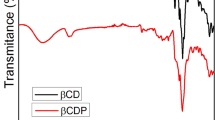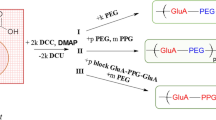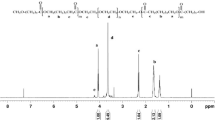Abstract
In this work, the degradation phenomena and the release kinetics of an active molecule from matrices systems made of random copolymers of ε-caprolactone (CL) and l-lactide (LA) were investigated by exposing the matrices, shaped as thin films, to simulated physiological environments. α-tocopherol was incorporated into the films as hydrophobic model molecule with the aim to investigate both its release pattern and its effect on erosion phenomena. In particular, the films have been kept at controlled conditions (temperature, stirring, pH) and they were characterized in terms of weight loss, water uptake, thermal properties, and change of number average molecular weight, in order to explain the molecule release kinetics and the degradation pathways of the copolymers. The main findings of this study are that the erosion phenomena take place significantly only when a critical value of the molecular mass was obtained in the sample; that the presence of the drug stabilizes the matrix and it decreases the rate of molecular mass decrease; and that crystallinity, reducing the chain mobility, causes lower erosion rates.






Similar content being viewed by others
Notes
Transesterification is the process of exchanging the alkoxy groups between polymer chains. There are two types of transesterification reaction: intramolecular leading to formation of cyclic oligomers and intermolecular leading to an increase in the range of chain lengths.
References
Ye WP, Du FS, Jin WH, Yang JY, Xu Y (1997) In vitro degradation of poly(caprolactone), poly(lactide) and their block copolymers: influence of composition, temperature and morphology. React Funct Polym 32:161–168
Huang MH, Li S, Hutmacher DW, Coudane J, Vert M (2006) Degradation characteristics of poly(α-caprolactone)-based copolymers and blends. J Appl Polym Sci 102:1681–1687
Albertsson A-C, Varma IK (2003) Recent developments in ring opening polymerization of lactones for biomedical applications. Biomacromolecules 4:1466–1486
Huang M-H, Li S, Vert M (2004) Synthesis and degradation of PLA–PCL–PLA triblock copolymer prepared by successive polymerization of ε-caprolactone and dl-lactide. Polymer 45:8675–8681
Kister G, Cassanas G, Bergounhon M, Hoarau D, Vert M (2000) Structural characterization and hydrolytic degradation of solid copolymers of d,l-lactide-co-ε-caprolactone by Raman spectroscopy. Polymer 41:925–932
Frank A, Rath SK, Venkatraman SS (2005) Controlled release from bioerodible polymers: effect of drug type and polymer composition. J Controlled Release 102:333–344
Dash TK, Konkimalla VB (2012) Poly-є-caprolactone based formulations for drug delivery and tissue engineering: a review. J Controlled Release 158:15–33
Lao LL, Venkatraman SS (2008) Paclitaxel release from single and double-layered poly (dl-lactide-co-glycolide)/poly (l-lactide) film for biodegradable coronary stent application. J Biomed Mater Res Part A 87:1–7
Wang S, Chen H, Cai Q, Bei J (2001) Degradation and 5-fluorouracil release behavior in vitro of polycaprolactone/poly (ethylene oxide)/polylactide tri-component copolymer. Polym Adv Technol 12:253–258
Garkhal K, Verma S, Jonnalagadda S, Kumar N (2007) Fast degradable poly (l-lactide-co-ε-caprolactone) microspheres for tissue engineering: Synthesis, characterization, and degradation behavior. J Polym Sci Part A 45:2755–2764
Hu Y, Jiang X, Ding Y et al (2003) Preparation and drug release behaviors of nimodipine-loaded poly (caprolactone)–poly (ethylene oxide)–polylactide amphiphilic copolymer nanoparticles. Biomaterials 24:2395–2404
D’Auria I, Lamberti M, Mazzeo M, Milione S, Roviello G, Pellecchia C (2012) Coordination chemistry and reactivity of zinc complexes supported by a phosphido pincer ligand, chemistry-A. Eur J 18:2349–2360
Manzanarez-López F, Soto-Valdez H, Auras R, Peralta E (2011) Release of α-tocopherol from poly(lactic acid) films, and its effect on the oxidative stability of soybean oil. J Food Eng 104:508–517
Renò F, Aina V, Gatti S, Cannas M (2005) Effect of vitamin E addition to poly(d,l)-lactic acid on surface properties and osteoblast behaviour. Biomaterials 26:5594–5599
Fischer E, Sterzel HJ, Wegner G (1973) Investigation of the structure of solution grown crystals of lactide copolymers by means of chemical reactions. Kolloid-Zeitschrift und Zeitschrift für Polymere 251:980–990
Crescenzi V, Manzini G, Calzolari G, Borri C (1972) Thermodynamics of fusion of poly-β-propiolactone and poly-ε-caprolactone. Comparative analysis of the melting of aliphatic polylactone and polyester chains. Eur Polym J 8:449–463
Palard I, Schappacher M, Belloncle B, Soum A, Guillaume SM (2007) Unprecedented polymerization of trimethylene carbonate initiated by a samarium borohydride complex: mechanistic insights and copolymerization with ε-caprolactone. Chem A Eur J 13:1511–1521
Barba AA, Chirico S, Dalmoro A, Lamberti G (2009) Simultaneous measurement of theophylline and cellulose acetate phthalate in phosphate buffer by UV analysis. Can J Anal Sci Spectrscop 53:249–253
Darensbourg DJ, Karroonnirun O (2010) Ring-opening polymerization of l-lactide and ε-caprolactone utilizing biocompatible zinc catalysts. Random copolymerization of l-lactide and ε-caprolactone. Macromolecules 43:8880–8886
Li G, Lamberti M, Pappalardo D, Pellecchia C (2012) Random copolymerization of ε-caprolactone and lactides promoted by pyrrolylpyridylamido aluminum complexes. Macromolecules 45:8614–8620
Florczak M, Duda A (2008) Effect of the configuration of the active center on comonomer reactivities: the case of ε-caprolactone/l, l-lactide copolymerization. Angew Chem Int Ed 47:9088–9091
Nomura N, Akita A, Ishii R, Mizuno M (2010) Random copolymerization of ε-caprolactone with lactide using a Homosalen–Al complex. J Am Chem Soc 132:1750–1751
Vanhoorne P, Dubois P, Jerome R, Teyssie P (1992) Macromolecular engineering of polylactones and polylactides. 7. Structural analysis of copolyesters of iε-caprolactone and l- or d,l-lactide initiated by triisopropoxyaluminum. Macromolecules 25:37–44
Faÿ F, Renard E, Langlois V, Linossier I, Vallée-Rehel K (2007) Development of poly(ε-caprolactone-co-l-lactide) and poly(ε-caprolactone-co-δ-valerolactone) as new degradable binder used for antifouling paint. Eur Polym J 43:4800–4813
Miller-Chou BA, Koenig JL (2003) A review of polymer dissolution. Prog Polym Sci 28:1223–1270
Grayson ACR, Cima MJ, Langer R (2005) Size and temperature effects on poly (lactic-co-glycolic acid) degradation and microreservoir device performance. Biomaterials 26:2137–2145
Park TG (1994) Degradation of poly (d,l-lactic acid) microspheres: effect of molecular weight. J Controlled Release 30:161–173
Husmann M, Schenderlein S, Lück M, Lindner H, Kleinebudde P (2002) Polymer erosion in PLGA microparticles produced by phase separation method. Int J Pharm 242:277–280
Gonçalves CMB, Tomé LC, Coutinho JAP, Marrucho IM (2011) Addition of α-tocopherol on poly(lactic acid): thermal, mechanical, and sorption properties. J Appl Polym Sci 119:2468–2475
Antheunis H, van der Meer J-C, de Geus M, Kingma W, Koning CE (2009) Improved mathematical model for the hydrolytic degradation of aliphatic polyesters. Macromolecules 42:2462–2471
Tsuji H, Ikada Y (1998) Blends of aliphatic polyesters. II. Hydrolysis of solution-cast blends from poly (l-lactide) and poly (E-caprolactone) in phosphate-buffered solution. J Appl Polym Sci 67:405–415
Acknowledgements
This work was supported by the Ministero dell’Istruzione dell’Università e della Ricerca-MIUR (contract grant number PRIN 2010/2011-20109PLMH2). Annalisa Dalmoro’s research grant was supported by “Strategie Terapeutiche Innovative”—STRAIN, POR Campania FSE 2007/2013. The Authors thank dr Ilaria D’Auria for the GPC measurements.
Author information
Authors and Affiliations
Corresponding author
Rights and permissions
About this article
Cite this article
Dalmoro, A., Barba, A.A., Lamberti, M. et al. Random l-lactide/ε-caprolactone copolymers as drug delivery materials. J Mater Sci 49, 5986–5996 (2014). https://doi.org/10.1007/s10853-014-8317-x
Received:
Accepted:
Published:
Issue Date:
DOI: https://doi.org/10.1007/s10853-014-8317-x




